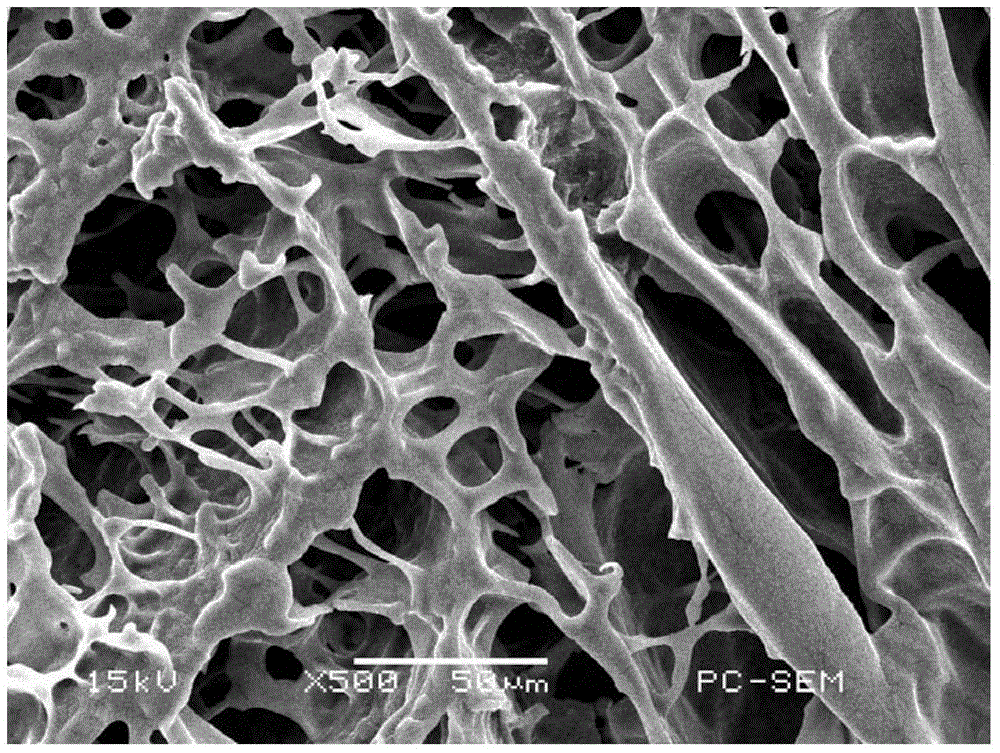Method for preparing nano-compound antibacterial dressing
A nano-composite, antibacterial agent technology, applied in medical science, bandages, absorbent pads, etc., can solve the problems of material spinning, film drawing difficulties, large R&D investment, slow antibacterial effect, etc., and achieve good UV shielding performance and low manufacturing cost. Inexpensive, wide range of effects
- Summary
- Abstract
- Description
- Claims
- Application Information
AI Technical Summary
Problems solved by technology
Method used
Image
Examples
Embodiment 1
[0029] (1) Preparation of nanocomposite antibacterial agent: silicon dioxide, titanium dioxide, zinc oxide, and magnesium oxide are dissolved in deionized water in a molar ratio of 40:20:15:25, and the concentration is prepared into a 5% aqueous solution; Add 0.5% cetyltrimethylammonium bromide as a surfactant and 1% Tween 20 as an emulsifier; transfer the solution to a three-necked flask, and stir for 2 hours at a temperature of T=40°C to obtain a uniform antibacterial agent dispersion;
[0030] (2) Preparation of polymer solution: directly dissolve the water-soluble polymer polyoxyethylene in deionized water, prepare an aqueous solution with a concentration of 3%, stir magnetically for 24 hours, and obtain a uniform polymer solution;
[0031] (3) Preparation of composite antibacterial dressing: Mix the polymer solution and the nanocomposite antibacterial agent at a mass ratio of 8:2, mechanically stir for 12 hours, and leave the solution ultrasonically to remove air bubbles ...
Embodiment 2
[0033] (1) Preparation of nano-composite antibacterial agent: silicon dioxide, titanium dioxide, zinc oxide, and magnesium oxide are dissolved in deionized water in a molar ratio of 40:20:15:25, and are mixed with an 8% aqueous solution; Add 0.5% cetyltrimethylammonium bromide as a surfactant and 1% Tween 20 as an emulsifier; transfer the solution to a three-necked flask, and stir for 2 hours at a temperature of T=40°C to obtain a uniform antibacterial agent dispersion;
[0034] (2) Preparation of polymer solution: directly dissolve the water-soluble polymer polyoxyethylene in deionized water, prepare an aqueous solution with a concentration of 3%, stir magnetically for 24 hours, and obtain a uniform polymer solution;
[0035] (3) Preparation of composite antibacterial dressing: Mix the polymer solution and the nanocomposite antibacterial agent at a mass ratio of 8:2, mechanically stir for 12 hours, and leave the solution ultrasonically to remove air bubbles in the solution; ...
Embodiment 3
[0037] (1) Preparation of nano-composite antibacterial agent: silicon dioxide, titanium dioxide, zinc oxide, and magnesium oxide are dissolved in deionized water in a molar ratio of 40:20:15:25, and are mixed with an 8% aqueous solution; Add 0.5% cetyltrimethylammonium bromide as a surfactant and 1.5% Tween 20 as an emulsifier; transfer the solution to a three-necked flask and stir for 2 hours at a temperature of T=60°C to obtain a uniform antibacterial agent dispersion;
[0038] (2) Preparation of polymer solution: directly dissolve the water-soluble polymer polyoxyethylene in deionized water, prepare an aqueous solution with a concentration of 3%, stir magnetically for 24 hours, and obtain a uniform polymer solution;
[0039] (3) Preparation of composite antibacterial dressing: Mix the polymer solution and the nanocomposite antibacterial agent at a mass ratio of 8:2, mechanically stir for 12 hours, and leave the solution ultrasonically to remove air bubbles in the solution; ...
PUM
| Property | Measurement | Unit |
|---|---|---|
| particle diameter | aaaaa | aaaaa |
| particle diameter | aaaaa | aaaaa |
Abstract
Description
Claims
Application Information
 Login to View More
Login to View More - R&D
- Intellectual Property
- Life Sciences
- Materials
- Tech Scout
- Unparalleled Data Quality
- Higher Quality Content
- 60% Fewer Hallucinations
Browse by: Latest US Patents, China's latest patents, Technical Efficacy Thesaurus, Application Domain, Technology Topic, Popular Technical Reports.
© 2025 PatSnap. All rights reserved.Legal|Privacy policy|Modern Slavery Act Transparency Statement|Sitemap|About US| Contact US: help@patsnap.com


